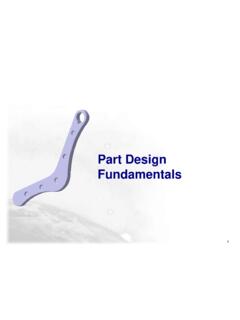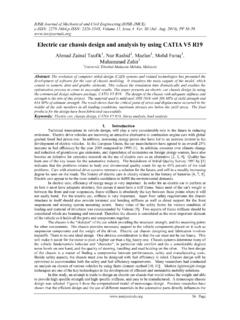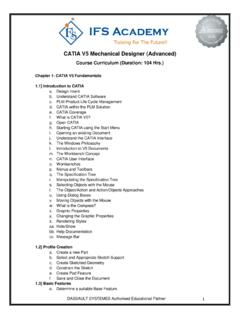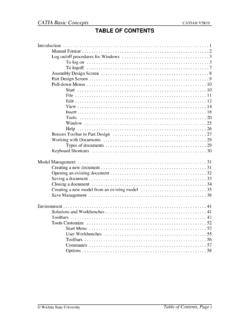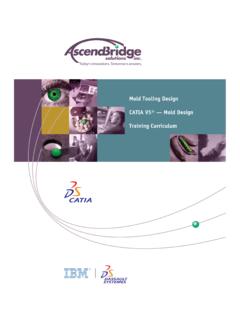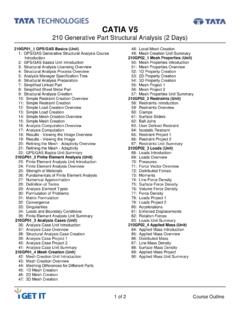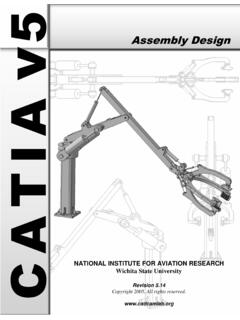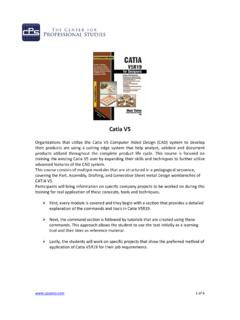Transcription of CATIA Composite Design, Analysis, and Manufacturing
1 Click to edit Master title styleCATIA Composite design , analysis , and ManufacturingDriving Innovation in the Automotive IndustryDriving Innovation in the Automotive IndustrySuccess Story: Terrafugia and the Transition Roadable Light Sport Aircraft(Date)()Jason Curtis, InceptraRani Richardson, Dassault Systemes1 Inceptra Helping engineering and Manufacturing companies solve mission critical business pchallenges since Portfolio of PLM SolutionsVirtual ProductionVirtualTe st i n gVirtual ProductPLMC ollaborationLifelike Experience3 DMCAD3 Aerospace CustomersNon Aerospace CustomersAutomotiveShipbuildingAutomotiv eShipbuildingWindConsultingResearchWindM aterialProvidersMaterial ProvidersInceptra Composite CustomersCAESCOCAESCOI ntroduction to Composites, DesignCompositesWhy use Composites ?Reduced WeightHighstiffnessandhighstrengthWhat is a Composite ?
2 Two or more engineered materials as amatrixandreinforcement(canHigh stiffness and high strengthHigh thermal resistanceHigh corrosion resistanceGood fatigue lifea matrix and reinforcement (can include plywood and concrete)Thermoset (Irreversible chemical reaction)Thl ti(blt dbhtThermoplastic (can be melted by heat and cool any number of times)Reinforcement fibersContinuous/long fibersOrganic Matrix Composites Metallic Matrix Composites (MMC)Ceramic Matrix Composites (CMC)WoodPolymer Matrix Composites (PMC) aka. Fiber Reinforced Plastics (FRP)Thermoset ResinThermoplastic ResinContinuous FibersShort FibersParticlesShort fibersSprayed fibersManualProcessesLiquidMoldingProces sesRobotic Compression AutomatedPlacementManual ProcessesLiquid Molding ProcessesProcessesMoldingAutomated PlacementSpray Lay upWet LayupHandLayupPrep LayupRTMVARTMRFI(Resin Film Infusion)RIMSCRIMPP ultrusionRobotic PreformingSMCBMCHot DrapingTape LayingFiber PlacementFilament WindingTypical Composites Challenges Long cycle timeDocumentation/Plybooks are time consumingLots of data to manageCost (Raw Materials, Affordability)))
3 Lack of Concurrent EngineeringTrial-and-Error in the Shop FloorLots of tedious geometrical tasksLack of Mock-up IntegrationNo integration between analysis and DesignNo Integration with highly specialized Manufacturing applicationsLack of ability to predict Manufacturing issues upfrontHard to simulate the globalapplicationsHard to simulate the global behavior of the Part Environmental Issues ( Regulations, Biodegradability, Recyclability, )Basic CATIA Composite design Concepts4 items in general describe the Composite Design1. Materials, along with neutral fiber direction2. Layup Surface, along with direction, therefore Associated Rosette3. Ply Boundary4. Ply StackupMaterial properties of a plyNCFNON CRIMPED FABRICNON STRUCTURALUNI DIRECTIONAL BI DIRECTIONAL UNDEFINED(Pre assembly of plies) ( Peel plies)UncuredthicknessCATIA V5 Material PropertiesUncured thickness(before polymerization)Material widthCured thickness(Finished product)DEFORMATIONDEFORMATION(During draping operations)Group of plies The Rosette (or axis system) gives the referenceforthefibersdirectionXaxisis0 reference for the fibers direction.
4 X axis is V5 Plies GroupDraping Direction indicates which direction the plies will be stackedA plies group is used to organize a group of plies logicallyPlies Group 3 Plies Group 1 Plies Group 2 Core GroupSequence (Ply bookkeeping)When creating a ply (next step) in a ply group, a sequence is automatically meaning of a sequence is the Manufacturing sequence. It contains the plies that can be laid on the mold during the same sequence in the 4, ply 4 and Ply 5 SEQ 5, ply 6 SEQ 6, ply 7 MOLDSEQ 1, ply 1 SEQ 2, Ply 2 SEQ 3, Ply 3 Ply BoundaryThe contour can be 1 geometry The contour can be a set of geometries Multiple contours are allowedgyforming a closed contourgforming a closed contour (with a tolerance) CATIA V5 PlyCreationAll the information relative to the ply are stored and visible in the specification Stackup Set the order of the Sequence/Plies Set the materials used Set the main fibers orientationsInteractive Ply Table Change Sequence/Ply Names Change Sequence/Ply Order Change Material Definition Change Material DirectionCATIA V5 PlyStackupCreationCATIA V5 PlyStackupCreationComposite design Downstream ResultsSolid creation A Solid Body can be generated from the Composite DesignNumerical analysis on Pliesthe Composite design The Solid can be used for Form and Fit Checks Center of Gravity analysis Mass Property analysis Total Ply area coverageCATIA V5 Composite ResultsCore sample Core Sampling results in a Ply Table at a locationIML Generation3D Section Done on Inspection locations Done on locations
5 Of interest Creates a Surface at top of plies Drop-offs and ramps are followed3D Section Cross Sections developed to understand Ply Stackup Drop-offs are shown Ramp sizes are controlledPlies Surfaces creation Top of Ply Surfaces can be explodedPly Creation design Approaches iSurface design and contours preperationTRANSITIONZONE 1 ZONE 2 Zones creationStack upZones creationZONE(TAPER)Transition zones creationManual plies creationStackupFull plies & ETBSS tack upFinalPliesManual Staggering(Limit Contours)StaggeringData fileFinal PliesPly TablePly Creation design Approaches Grid ApproachSolid Slicing ApproachExcel Sheet ApproachPre designDetailed designZ1Z2 NameZ1Z2 SectionNameZ1Z2 Carbon 0 22 Kevlar 0 20 introduction to Composites, analysis SIMULIA for composites structures performancesNEWB asic CATIA Composite analysis Concepts4 items in general describe the Composite analysis Process1.
6 Mesh, along with ply boundary adherence2. Materials, along with neutral fiber direction3. Loads and Boundary conditions4. Solving and Post processingCATIA analysis / CATIA Composites integrationCPD model: surface, the FEM based on the CATPartMesh and properties imported from CPDLoad, BC and Simulation PtiPost processingModification on the CPD modelUpdate Simulation MeshingNo transfer of geometry : CATIA analysis is CATIA !FMSP owerfulQUADM esherwithmultiplealgorithmsFMS: Powerful QUAD Mesherwith multiple algorithmsTopology simplification for complex geometrySemi automatic mesher with mesh morphing capabilityCATIA V5 MeshingConstrain the mesh onto CPD entitiesPlies contourGrid Panel or Zones contourgMaterial MappingAssociative CPD data importPlies and CoreZonesZonesTransferproducibilityforsi mulationwithtruefiberdirectionCATIA V5 Material MappingTransfer producibilityfor simulation with true fiber directionUseful especially for curved surface and for beam (fibers along seed curve)
7 Dedicated pre processing visualization ppgLoads and Boundary ConditionsRestraintsUsed to fix Degrees of FreedomClampsfixall6degreesofFreedomCATI A V5 Loadsand BoundaryClamps fix all 6 degrees of FreedomLoadsUsed to apply forces to the modelyConditionsUsed to apply forces to the modelImpose DisplacementSolver ELFINIL inear Solver CATIA Elfini simulates CompositesAssemble orthotropic properties defined for each materialLinearstaticanalysisLinear static analysis Mechanical loadTemperature distributionFrequencyBuckling analysisgyAssembly of AnalysisBonded partsCbidiCombined static casesFor exact same FEA, results are the same as SIMULIA AbaqusCATIA V5 SolvingLinear static caseUniform pressurepPost-ProcessingPly per ply visualizationDedicatedFailurecriteriafor pliesDedicated Failure criteria for pliesMaximum FailureTsai HillHffHoffmanTsai WuElilithiffilit ifllfthliCATIA V5 Post-ProcessingEnvelope case.
8 Visualize the maximum of failure criteria for all of the pliesAbaqus Composite Capabilities Today EASY composites modeling / meshing Linear static analysis evaluating ply-by-ply stresses Fracture / crack growth in composites Customer requested Composite capabilities Fracture / crack growth in composites Delaminationdue to thermal loads Calculation of failure theories Tsai-Wu, Tsai-Hill, Max Strain, Max Stress VCCT analysis Interlaminar shear predictions Manufacturing simulation Calculation of flat patterns High speed / ballistic impact Draping analysis Draping analysis Buckling and post-buckled performance Macro-modeling capabilities Micro-modeling capabilities Crashworthiness of composites/ Thru-thickness stress / strain plots BVID (Barely Visible Impact Damage) Visualization of ply stack-ups Interface with EXCEL for layup definitions User defined damage modeling User defined damage modeling Designer-centric Composite modelingAbaqus = Realistic Simulation of CompositesComposites Pre / Post in Abaqus/CAEC rack propagation using VCCTC rack propagation using XFEMD raping in Abaqus/CAEB allistic ImpactBallistic ImpactC ChDelaminationComposites CrushIntroduction to CATIA Composites, ManufacturingBasic CATIA Composite Manufacturing Concepts4 items in general describe the Composite Manufacturing Process1.
9 Preparation of design Model for Manufacturing2. Ply Producibility and Flattening of Plies3. Export of Flattened Plies4. Plybook CreationComposite Manufacturing ConsiderationsWhy to create a new file for Manufacturing preparation?ItallowsconcurrentFor physical reasons: manufactured plies are not equal to engineering plies. It allows concurrent engineering between engineering and Manufacturing preparation. Spring back/WarpingTotal development cycle timeEngineeringManufacturingExcess of material at the ply EngineeringNo concurrent engineeringboundariesManufacturingConcur rent engineeringTime earnedManufacturing strategies compliance (tapes, )Preparation of design Model for Mfg., Material ExcessBoundariesMainly due to Manufacturing processes,the Manufacturing contours are different from the engineering contours.
10 There is a compromise between quality and raw materials keep clean avoid deformation, it is better to cut the boundaries, it is mandatory to add an excess of V5 MaterialExcessComplex boundariesholes after curingSpecific Manufacturing process ( tapes)fCATIA avoid triangular tapes, the boundary is modified. To avoid deformation, it is better to cut after curingPly ProducibilityThe producibility analysis is a iltifthfibdf tisimulation of the fibers deformations on the molded surface due to the shape of the Composite part and the draping processThditilll dThe seed point is also called strategy point . It is the point where the operator begins to place the ply (the first contact point between the ply andthemold)and the mold)Deformed weftCATIA V5 Ply ProducibilityDeformedwarpPly FlatteningAt this step, it is possible to display theflatpatternthe flat pattern, and check the material V5 Flat PatternsThe flatten ply is computed from the fibers deformation analysis .

